
The insects of the beetle family Chrysomelidae are commonly known as leaf beetles, and include over 37,000 species in more than 2,500 genera, making up one of the largest and most commonly encountered of all beetle families. Numerous subfamilies are recognized, but the precise taxonomy and systematics are likely to change with ongoing research.
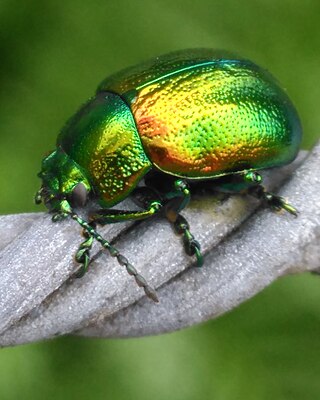
The tansy beetle is a species of leaf beetle. The common name derives from its main foodplant, Tansy, but it can also use other wetland plants such as Gypsywort and Water Mint. It measures 7.7–10.5 mm in length and has a characteristic bright metallic green colouration, with pitted elytra and a coppery tinge. In addition to the nominotypical subspecies, which repeats the specific name, C. graminis graminis, there are five further distinct subspecies of Tansy beetle, which, collectively, have a Palearctic distribution, although in the majority of countries where it is found the species is declining. In the United Kingdom it is designated as 'Nationally Rare'. The stronghold population here is located along the banks of the river Ouse in York, North Yorkshire. Other, small, fenland populations exist at Woodwalton Fen and at Welney Wildfowl and Wetlands Trust (WWT) reserve.

The scarlet lily beetle, red lily beetle, or lily leaf beetle, is a leaf beetle that eats the leaves, stem, buds, and flowers, of lilies, fritillaries and other members of the family Liliaceae. It lays its eggs most often on Lilium and Fritillaria species. In the absence of Lilium and Fritillaria species, there are fewer eggs laid and the survival rate of eggs and larvae is reduced. It is now a pest in most temperate climates where lilies are cultivated.

The flea beetle is a small, jumping beetle of the leaf beetle family (Chrysomelidae), that makes up the tribe Alticini which is part of the subfamily Galerucinae. Historically the flea beetles were classified as their own subfamily.
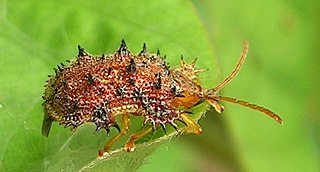
The Cassidinae are a subfamily of the leaf beetles, or Chrysomelidae. The antennae arise close to each other and some members have the pronotal and elytral edges extended to the side and covering the legs so as to give them the common name of tortoise beetles. Some members, such as in the tribe Hispini, are notable for the spiny outgrowths to the pronotum and elytra.

Chrysolina cerealis, the rainbow leaf beetle or Snowdon beetle, is a beetle belonging to the family Chrysomelidae.
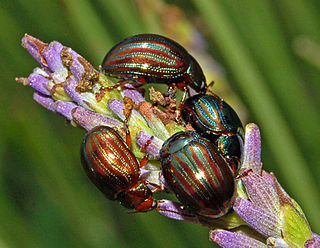
Chrysolina americana, common name rosemary beetle, is a species of beetle belonging to the family Chrysomelidae.

Chrysolina is a large genus of leaf beetles in the subfamily Chrysomelinae. Most species are distributed in Europe, Asia and Africa with a small number of species inhabiting North America and introduced species in Australia.

Chrysolina grossa, the red leaf beetle, is a species of broad-shouldered leaf beetles belonging to the family Chrysomelidae, subfamily Chrysomelinae.

Anoplotrupes stercorosus, the dor beetle, is a species of earth-boring dung beetle belonging to the family Geotrupidae, subfamily Geotrupinae.

Leptinotarsa haldemani, commonly known as Haldeman's green potato beetle, is a glossy green-colored species of beetle in the leaf beetle family Chrysomelidae. It was named in honour of Samuel Stehman Haldeman, a 19th-century American entomologist who collected insect specimens in Texas.
Longitarsus suturellus is a species of beetle in the subfamily Galerucinae. It is distributed in the Palearctic realm from the Pyrenees to Japan. Adult beetles and larvae feed on the leaves of sage (Senecio) (Asteraceae).

Chrysolina fastuosa, also known as the dead-nettle leaf beetle, is a species of beetle from a family of Chrysomelidae found in Europe, Caucasus and northern Turkey.

Chrysolina herbacea, also known as the mint leaf beetle, or green mint beetle, is a species of beetle in the family Chrysomelidae.
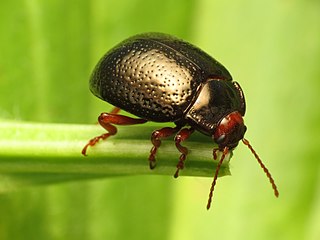
Chrysolina bankii is a species of leaf beetle native to western Europe and the western Mediterranean Basin. It has also been introduced to the US, where its range is expanding.

Hemisphaerota cyanea, known generally as palmetto tortoise beetle, is a species of leaf beetle in the family Chrysomelidae. Other names include the Florida tortoise beetle and iridescent blue chrysomelid beetle. It is native to the southeastern United States, from North Carolina, south to Florida, and west to Mississippi. It is introduced to southern Texas.
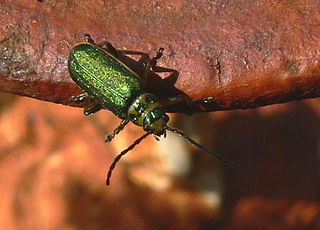
Trirhabda flavolimbata, also called the coyote brush leaf beetle, is a species of skeletonizing leaf beetle in the family Chrysomelidae. It is found in California in coastal scrublands or chaparral habitats. Its main host plant is coyote brush, but it has been noted to feed on other species of Baccharis, as well as Aster, Senecio, Artemisia, Solidago, and Eriodictyon.

Chrysolina haemoptera, also known as the plantain leaf beetle, is a species of leaf beetle in the genus Chrysolina. They are associated with plantains (Plantago), particularly Plantago coronopus.

Lamprolina is an Australian genus of leaf beetles (Chrysomelidae) found in Victoria, New South Wales, and Queensland.





















